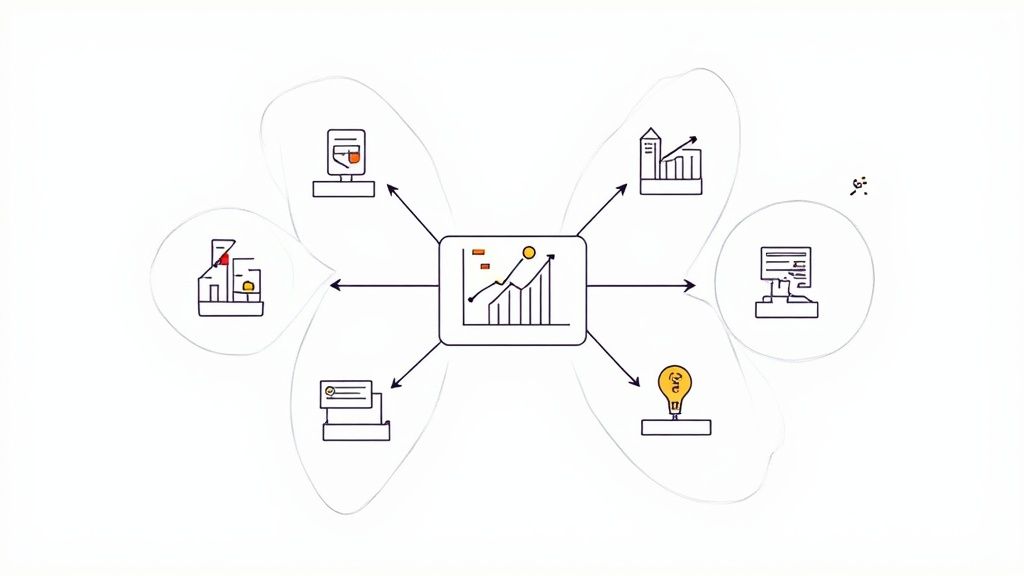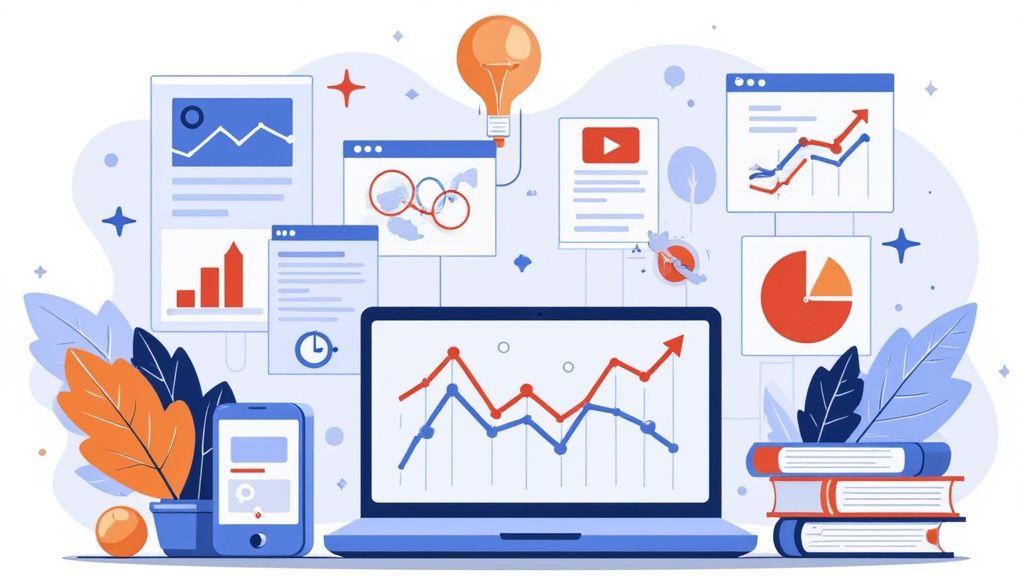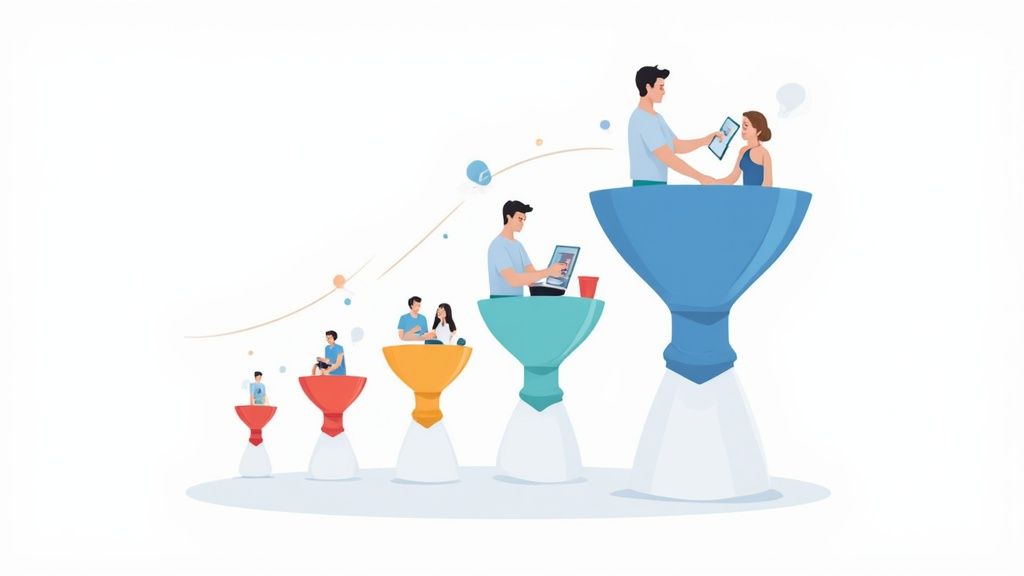The Evolving Landscape of B2B Lead Generation

Traditional B2B lead generation tactics, like cold calling and generic email blasts, are becoming less effective. Today’s B2B buyers are more informed and discerning. They conduct extensive online research and resist overt sales pitches. Businesses must adapt their strategies to resonate with this new type of buyer. This requires understanding the changing dynamics of connecting with a target audience.
One key change is the shift from volume-based metrics to lead quality. Instead of aiming for a large number of leads, businesses prioritize those likely to convert into paying customers. This involves attracting the right leads, not just any lead. Challenges in B2B lead generation are widespread.
41% of B2B marketers struggle to generate more leads, while 54% find it difficult to improve lead quality and conversion rates. Find more detailed statistics here: B2B Lead Generation Statistics. Refining strategies to address these common pain points is now more critical than ever.
The Rise of Buyer-Centric Approaches
Another significant evolution is the rise of buyer-centric approaches. This puts the buyer’s needs and preferences at the center of lead generation. Instead of pushing products or services, businesses provide valuable content and resources that help buyers solve their problems. This builds trust and establishes the business as a thought leader. Consequently, this requires a deeper understanding of the buyer’s journey.
The Importance of Personalization
Personalization is now crucial for effective B2B lead generation. Buyers expect personalized experiences tailored to their specific needs and interests. This includes customizing content, messaging, and offers. Using data and analytics to understand buyer behavior allows businesses to deliver the right message at the right time. This targeted approach is more effective than generic marketing.
Integrating Sales and Marketing
The increasing integration of sales and marketing teams plays a vital role in successful B2B lead generation. When these teams collaborate effectively, they create a more cohesive and effective lead generation process. This improved collaboration ensures that leads are nurtured effectively and passed to sales at the right time, ultimately improving conversion rates and driving revenue growth. The evolving landscape of B2B lead generation emphasizes adapting to changing buyer behaviors and embracing a more strategic, customer-focused approach.
Content That Converts: Your B2B Lead Generation Engine

Generic content doesn’t connect with today’s B2B buyers. Focusing on content that converts requires understanding the buyer’s journey and providing real value. This goes beyond simply generating traffic. It’s about attracting qualified leads. B2B lead generation relies on targeted strategies, and content marketing is increasingly important.
In fact, 85% of B2B marketers use content for lead generation, compared to 60% of B2C marketers. This highlights the power of valuable content in attracting potential buyers. Learn more: Lead Generation Stats.
Crafting Thought Leadership Content
Successful B2B teams know the importance of thought leadership. This means creating content that positions your company as a trusted advisor. In-depth blog posts, white papers, and webinars offering industry insights can build credibility and attract customers. This makes your brand a go-to resource for decision-makers.
Addressing Pain Points at Each Stage
Effective content addresses specific pain points at every stage of the buyer’s journey. During the awareness stage, educational content about the problem and potential solutions is key. As buyers move into the consideration stage, comparisons, case studies, and product demos become more relevant. Finally, in the decision stage, pricing, testimonials, and free trials can help secure the purchase.
Building a Consistent Content Calendar
A consistent content calendar ensures your audience receives regular, valuable information. This builds engagement and strengthens your position as a thought leader. However, flexibility is crucial. Regularly evaluate your content’s performance and adjust your strategy as needed.
Content Distribution Strategies
Creating great content is just the first step. Reaching the right audience requires a solid distribution strategy. This might involve promoting your content through social media, email marketing, paid advertising, and relevant industry publications. Effective distribution gets your material in front of decision-makers.
Choosing the Right Content Formats
Different content formats perform differently at various stages of the buyer’s journey. Understanding these nuances is vital for maximizing B2B lead generation. The following table offers a comparison of content effectiveness:
To help visualize these differences, let’s examine a table summarizing the effectiveness of various content types across the buyer’s journey.
B2B Content Types by Effectiveness: A comparison of different content formats and their effectiveness at various stages of the buyer’s journey.
| Content Type | Awareness Stage | Consideration Stage | Decision Stage | Average Conversion Rate |
|---|---|---|---|---|
| Blog Posts | High | Medium | Low | 2.5% |
| White Papers | Medium | High | Medium | 4.5% |
| Case Studies | Low | High | High | 7% |
| Webinars | Medium | High | Medium | 5% |
| Videos | High | Medium | Medium | 3% |
Using a mix of formats allows you to engage prospects throughout their decision-making process and improve lead generation. This involves understanding each format’s strengths and weaknesses and adjusting your approach accordingly. This targeted approach optimizes your content strategy for maximum impact.
Mastering LinkedIn For B2B Lead Generation

LinkedIn has evolved into a crucial tool for B2B lead generation. It’s no longer just a platform for posting updates; it’s a dynamic space for connecting with key decision-makers. Understanding how successful organizations leverage LinkedIn’s features to achieve tangible results is essential. This goes beyond simple metrics like likes and shares; it’s about building a powerful lead generation machine.
Optimizing Your LinkedIn Profile
Your LinkedIn profile serves as your digital first impression. It needs to be more than a static resume; it should be a compelling narrative showcasing your expertise and value proposition. This approach attracts potential leads and builds credibility. Ensure your headline and summary clearly articulate your offerings to your target audience.
- Use a professional headshot: A professional headshot builds trust and enhances engagement with your profile.
- Highlight your expertise: Clearly showcase your skills and experience that are relevant to your ideal clients.
- Include a clear call to action: Make it easy for prospective clients to connect with you and explore your offerings.
Creating Engaging Content
Content remains king, even on LinkedIn. Sharing valuable insights and thought-provoking content engages your audience and establishes your position as an industry leader. This not only attracts potential clients but also stimulates meaningful conversations. This content can manifest in various formats.
- Share industry news and analysis: Provide your unique perspective on relevant industry trends and developments.
- Post original articles and blog posts: Share your expertise and deliver valuable information through original content.
- Use visuals: Incorporating images and videos boosts engagement and makes your content more memorable.
Leveraging LinkedIn’s Advanced Search
LinkedIn’s advanced search functionality is a powerful asset for identifying high-potential leads. By using advanced filters, you can precisely target specific industries, job titles, locations, and other criteria. This focused approach allows you to connect with the right individuals and cultivate valuable relationships, significantly improving your lead generation effectiveness.
44% of B2B marketers consider LinkedIn their primary platform for lead generation, highlighting its effectiveness in reaching decision-makers. For further insights into this, explore these Lead Generation Statistics. LinkedIn’s influence on B2B success is undeniable.
Using LinkedIn Groups Strategically
Engaging in relevant LinkedIn groups provides valuable opportunities to connect with potential clients and participate in industry discussions. This strengthens relationships and establishes your expertise within your target market. However, strategically selecting groups where your ideal clients are active is crucial.
Harnessing LinkedIn Live and Events
LinkedIn Live and Events offer dynamic avenues for engaging with your audience in real-time. Hosting webinars, Q&A sessions, or product demos provides valuable content and reinforces your authority. These events can generate leads, build brand awareness, and offer a platform for direct interaction with potential customers.
Utilizing InMail Effectively
InMail can be a highly effective tool for directly contacting prospects. However, to avoid being overlooked, personalize your messages and offer genuine value. Steer clear of generic pitches and focus on addressing their specific challenges. A well-crafted InMail can be a powerful lead generation tactic.
Integrating Paid Strategies
While organic strategies are fundamental, LinkedIn’s paid advertising options can substantially amplify your reach. Targeted campaigns enable you to connect with a broader audience of potential leads based on demographics, interests, and job titles. This facilitates a more focused approach to B2B lead generation. By integrating both organic and paid strategies, you can maximize your impact on LinkedIn.
Building a B2B Website That Actually Generates Leads

Many B2B websites serve primarily as online brochures, simply showcasing products and services without a strategy for capturing leads. However, a website can be a powerful lead generation engine. By analyzing high-converting B2B websites, we can identify key elements that encourage prospects to take action. This requires a shift from passively presenting information to actively engaging visitors and nurturing them into qualified leads.
Why B2B Forms Often Fail
One common reason for low conversion rates is the presence of overly complex or intrusive forms. Asking for too much information can deter potential leads. Successful B2B companies strike a balance between gathering necessary data and providing a seamless user experience.
Streamlining your forms by requesting only essential information can dramatically improve conversion rates. Respecting a visitor’s time encourages form completion and builds trust.
Landing Page Design and Calls to Action
High-converting landing pages have a single, clear call to action (CTA). A focused CTA directs visitors towards the desired outcome: downloading a resource, requesting a demo, or contacting the sales team.
Clear, concise copy directly addressing the visitor’s pain points is also essential. Strategically placed CTAs throughout the landing page maximize visibility and conversion opportunities.
Compelling Copy and Lead Magnets
Persuasive copy that resonates with decision-makers is crucial for B2B lead generation. Understanding your target audience and their unique challenges allows you to craft messaging that speaks directly to their needs.
Offering valuable lead magnets like white papers, ebooks, or webinars, in exchange for contact information, is a proven method for boosting lead generation. These resources provide immediate value to the prospect while capturing their information for future nurturing.
Mobile Optimization and User Behavior
A seamless mobile experience is paramount. Ensuring your website is fully optimized for mobile devices keeps prospects engaged and improves conversion rates. Many prospects conduct initial research from their mobile devices.
Utilizing behavioral analytics tools like Hotjar or Google Analytics provides insights into how visitors interact with your website. This data helps make data-driven adjustments for optimal performance. Tracking user behavior identifies areas for improvement, allowing for continuous optimization of your website’s effectiveness.
To illustrate these important elements, let’s examine the following comparison:
The table below, “B2B Website Conversion Elements Comparison,” analyzes key website elements and their respective impact on lead generation conversion rates. It provides a practical guide for prioritizing improvements.
| Website Element | Industry Average Implementation | Impact on Conversion Rate | Implementation Difficulty | Recommended Priority |
|---|---|---|---|---|
| Clear and Concise CTAs | 60% | High | Low | High |
| Mobile-Optimized Design | 75% | Medium | Medium | High |
| Valuable Lead Magnets | 50% | High | Medium | High |
| User-Friendly Forms | 40% | High | Low | High |
| Behavioral Analytics Integration | 30% | Medium | Medium | Medium |
As the table highlights, focusing on clear CTAs, mobile optimization, lead magnets, and user-friendly forms provides the biggest impact with relatively low implementation difficulty. While analytics integration is valuable, it’s recommended to prioritize the other elements first. By addressing these key areas, B2B companies can significantly improve website lead generation. Prioritizing these improvements transforms your website into a powerful lead generation machine.
Email Nurturing Strategies That Move B2B Prospects Forward
Generic email sequences often result in low conversion rates and a surge in unsubscribes. Instead of pushing for immediate sales, successful B2B companies cultivate relationships through email nurturing. This fosters trust and guides prospects naturally through the sales funnel, transitioning from impersonal blasts to personalized communication.
Segmentation for Personalized Messaging
Effective email nurturing begins with segmentation. By dividing your audience into groups based on criteria like industry, behavior, or buying stage, you can craft more relevant messages. For example, a prospect who downloaded a white paper on cloud security has different needs than someone who attended a webinar on project management. This targeted approach significantly improves engagement.
Compelling Subject Lines and Email Content
Subject lines are the gatekeepers to your emails. They decide whether a prospect opens your message or deletes it. Compelling subject lines are concise, intriguing, and personalized. Valuable content within the email is paramount. Focus on providing information that helps the prospect solve a problem or achieve a goal. This positions your company as a helpful resource, not just another vendor.
- Personalize the greeting: Addressing the recipient by name creates a more personal connection.
- Keep it concise: Respect your recipient’s time by delivering your message efficiently.
- Include a clear call to action: Clearly state the next step you want the recipient to take, whether it’s downloading a resource, visiting a landing page, or scheduling a call.
Drip Campaign Structures for Building Momentum
Drip campaigns automate a series of emails delivered over a set period. This gradual approach cultivates trust and keeps your brand top-of-mind. A well-structured drip campaign begins with educational content and gradually introduces product-specific information as the prospect nears a decision.
Technical Elements and Automation for Deliverability and Scalability
Reaching your audience’s inbox requires attention to technical details. Ensuring your emails bypass spam filters and maintaining a clean email list is vital for deliverability. Marketing automation tools help scale your email nurturing efforts. These platforms automate email delivery, personalize content, and track campaign performance, freeing your team to focus on strategy and content creation.
Measuring Email Effectiveness Beyond Vanity Metrics
While email open rates and click-through rates offer surface-level insights, tracking metrics that reflect actual conversion is crucial for understanding your email nurturing’s impact. These include:
- Lead scoring: Assign points to leads based on email and website interactions to identify qualified prospects.
- Sales conversions: Track how many nurtured leads convert into paying customers.
- Customer lifetime value: Measure the long-term revenue generated by customers acquired through email nurturing.
By focusing on these metrics, you can continually refine your email nurturing strategies for improved B2B lead generation. This data-driven approach transcends vanity metrics, emphasizing factors that drive business growth. Focusing on quality engagement and conversion transforms email nurturing into a powerful engine for B2B lead generation. ReachLabs.ai understands these challenges and applies proven strategies to help businesses thrive. We’re ready to partner with you to transform your email nurturing into a powerful driver of growth. Learn more about email nurturing with ReachLabs.ai.
Overcoming Critical B2B Lead Generation Roadblocks
Even with a well-defined strategy, B2B lead generation can present significant challenges. Businesses often encounter obstacles that hinder their progress and impact their results. This section explores common roadblocks and offers practical solutions to help companies improve their lead generation outcomes.
Improving Lead Quality Through Scoring and Targeting
Generating a high volume of leads is ineffective if those leads don’t convert into customers. Implementing a lead scoring system helps prioritize high-potential leads by assigning points based on engagement, demographics, and buying stage. This allows sales teams to concentrate on the most promising prospects.
Refining targeting criteria is also crucial. A clearly defined ideal customer profile (ICP) ensures your marketing efforts reach the right audience. This targeted approach not only improves lead quality but also minimizes wasted resources. Analyzing existing customer data and conducting market research are key to understanding your ideal prospects.
Building robust buyer profiles or “buyer personas” provides deeper insights than basic demographics. Understanding buyer motivations, pain points, and buying process informs content creation and targeting strategies, leading to more qualified leads. Consider factors like company size, industry, job role, and purchasing behavior when crafting these profiles.
Shortening Sales Cycles Without Sacrificing Relationship Quality
Long B2B sales cycles are a common hurdle. However, shortening them doesn’t mean neglecting relationship building. Providing valuable content at each stage of the buyer’s journey accelerates the decision-making process. Interactive tools, personalized demos, and accessible pricing information empower buyers and can move them through the sales funnel more efficiently.
Maximizing ROI on Limited Marketing Budgets
Budget limitations are a reality for many businesses. Maximizing ROI with limited resources requires a strategic approach. Focus on channels and tactics proven effective for your target audience. Regularly analyzing campaign performance and making data-driven adjustments ensures efficient resource allocation, preventing wasted ad spend and maximizing lead generation effectiveness. Consider using tools like Google Analytics to track and analyze campaign performance.
Breaking Through Crowded Digital Channels
Standing out in the crowded digital landscape requires creativity and strategic thinking. Developing unique and compelling content that resonates with your target audience is essential. Exploring niche channels and communities where your ideal prospects are active can be a highly effective way to cut through the noise and grab their attention.
Aligning Sales and Marketing Teams for Shared Goals
Alignment between sales and marketing teams is fundamental for success. Clear communication channels and shared metrics foster collaboration. Regular meetings to discuss lead generation strategies and progress keep both teams on the same page. This unified approach improves lead quality and boosts conversion rates. Using a shared CRM can facilitate communication and tracking.
Creating Closed-Loop Reporting for Continuous Improvement
Closed-loop reporting provides a complete view of the lead generation process. By tracking leads from initial contact to conversion, businesses identify strengths and weaknesses. This data-driven approach allows for continuous optimization of lead generation strategies. Regular review and analysis foster improvement and drive better results. For example, consistently low-quality leads from a specific source indicate the need to adjust targeting or messaging. This iterative process ensures that your B2B lead generation efforts are always optimized. ReachLabs.ai helps companies overcome these challenges and build effective lead generation strategies. Contact ReachLabs.ai to discuss your B2B lead generation goals.
Measuring What Matters in B2B Lead Generation
Stop chasing vanity metrics. This section focuses on establishing measurement frameworks that connect your lead generation efforts to tangible business outcomes. We’ll explore which Key Performance Indicators (KPIs) truly matter at each stage of the sales funnel and how to establish tracking systems that provide a holistic view of the customer journey across various touchpoints.
Essential KPIs for Each Funnel Stage
Different KPIs provide valuable insights at different stages. At the top of the funnel, metrics like website traffic, content downloads, and social media engagement indicate reach and brand awareness.
For example, tracking downloads of your latest white paper can reveal the effectiveness of your content marketing strategy in attracting potential leads.
As prospects move to the middle of the funnel, focus shifts to engagement metrics such as email open rates, click-through rates, and webinar attendance. These metrics provide insights into how effectively you are nurturing leads and moving them closer to a purchasing decision.
Finally, at the bottom of the funnel, KPIs like sales conversions, deal size, and customer lifetime value reflect the effectiveness of your lead nurturing and sales processes. Closing deals and generating revenue are the ultimate goals, and these KPIs measure your success in achieving them.
Setting Up Effective Tracking Systems
Tracking the complete customer journey is crucial for understanding which strategies are working. This requires implementing tools like website analytics (Google Analytics), CRM systems (Salesforce), and marketing automation platforms (HubSpot) to capture data across multiple touchpoints.
For instance, integrating your CRM with your email marketing platform allows you to track which emails lead to conversions. This integrated approach provides a comprehensive picture of the customer journey, from initial contact to final sale. By understanding the entire process, you can identify areas for improvement and optimize your lead generation efforts.
A/B Testing for Data-Driven Optimization
A/B testing helps refine your strategies based on data, not guesswork. By testing different versions of landing pages, emails, or ad copy, you can identify which variations perform best. This data-driven approach ensures that your lead generation tactics are continually improving.
Testing provides statistically significant insights, enabling informed decisions based on real-world performance. For example, testing different headlines on a landing page can reveal which version resonates most effectively with your target audience.
Leveraging Your CRM for Enhanced Decision-Making
Many businesses underutilize their CRM. Beyond basic contact storage, a CRM can be a powerful tool for analyzing lead behavior, segmenting audiences, and tracking sales performance.
This improves data quality and provides insights for better decision-making. This means using your CRM for analysis and strategy, not just as a digital Rolodex. By leveraging the full potential of your CRM, you can gain a deeper understanding of your leads and improve your overall lead generation strategy.
Understanding Attribution Models for Smarter Budget Allocation
Attribution models help determine which marketing channels are most effective in driving valuable leads. Understanding how different touchpoints contribute to conversions informs budget allocation decisions.
For example, if you discover that LinkedIn campaigns consistently generate high-quality leads, you might allocate more budget to that channel. This strategic approach optimizes your spending for maximum impact. By understanding the role of each channel in the customer journey, you can allocate your budget more effectively and maximize your return on investment.
Regular Performance Reviews for Continuous Improvement
Regular performance reviews are crucial for staying on track. Establishing a framework for evaluating lead generation results, without getting bogged down in data, keeps your efforts focused. This allows you to identify areas for improvement and adjust strategies as needed.
This ensures that you’re not just gathering data, but using it to continually improve your B2B lead generation efforts. Regular reviews help you stay agile and adapt to changing market conditions, ensuring that your lead generation strategy remains effective.
ReachLabs.ai can partner with you to develop a data-driven approach that ensures you’re measuring what truly matters. Let us help you transform your lead generation strategy.





